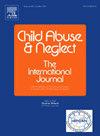青少年自我报告的童年受虐模式与 COVID-19 相关的抑郁和问题行为:中国的一项纵向研究。
IF 3.4
2区 心理学
Q1 FAMILY STUDIES
引用次数: 0
摘要
背景:现有研究探讨了童年受虐经历在COVID-19大流行期间青少年心理和行为反应中的作用,但仍不清楚不同的童年受虐模式对这些心理和行为问题是否具有敏化或强化作用:为了阐明童年虐待对青少年日后不良经历的感化或强化作用,本研究探讨了童年虐待的模式,并评估了这些模式在大流行期间对青少年抑郁症状和问题行为的影响:共选取了1890名青少年(969名女性,平均年龄14岁;187名来自单亲家庭,858名是家中独子),在三个时间点(2019年11月、2020年11月和2021年11月)完成自我报告问卷:方法:采用潜在特征分析确定童年受虐模式,并采用线性回归分析评估童年受虐模式对大流行病期间抑郁症状和问题行为的预测作用:潜在特征分析确定了五个不同的组别:高身体/情感虐待组、中度身体/情感虐待组、高情感虐待组、矛盾虐待组和低身体/情感虐待组。与身体/情感虐待程度低的组别相比,身体/情感虐待程度高的组别和中度虐待组别中的青少年与大流行期间的问题行为呈持久的正相关,而虐待情绪矛盾组别中的青少年与大流行期间的抑郁症状呈长期的正相关:结论:在大流行病期间,先前存在的童年虐待行为对抑郁症状和问题行为的影响是敏化作用而非强化作用。此外,长期的敏化效应主要发生在高度和中度身体/情感虐待组以及矛盾虐待组。本文章由计算机程序翻译,如有差异,请以英文原文为准。
Self-reported patterns of childhood abuse and COVID-19 related depression and problematic behaviors in adolescents: A longitudinal study from China
Background
Extant studies have examined the role of childhood abuse experiences in adolescents' mental and behavioral reactions during the COVID-19 pandemic, but it remained unclear whether different childhood abuse patterns had sensitizing or steeling effects on these psychological and behavioral problems.
Objective
To elucidate the sensitizing or steeling effect of childhood abuse on subsequent adverse experiences, the current study examined patterns of childhood abuse and assessed their effects on adolescents' depressive symptoms and problematic behaviors during the pandemic.
Participants and setting
In total, 1890 adolescents (969 females, mean age 14 years; 187 from a single-parent family, 858 were the only child in their family) were selected to complete self-report questionnaires at three time points (November 2019, November 2020, and November 2021).
Methods
Latent profile analysis was used to identify patterns of childhood abuse, and linear regression analysis was used to assess the predictive effects of childhood abuse patterns on depressive symptoms and problematic behaviors during the pandemic.
Results
The latent profile analysis identified five distinct groups: high physical/emotional abuse group, moderate physical/emotional abuse group, high emotional abuse group, ambivalent abuse group, and low physical/emotional abuse group. Compared with those in the low physical/emotional abuse group, adolescents in the high and moderate physical/emotional abuse groups had a lasting positive association with problematic behaviors, and adolescents in the ambivalent abuse group had a long-term positive association with depressive symptoms during the pandemic.
Conclusions
Preexisting childhood abuse had a sensitizing rather than a steeling effect on depressive symptoms and problematic behaviors during the pandemic. Furthermore, the long-term sensitizing effects mainly occurred in the high and moderate physical/emotional abuse and ambivalent abuse groups.
求助全文
通过发布文献求助,成功后即可免费获取论文全文。
去求助
来源期刊

Child Abuse & Neglect
Multiple-
CiteScore
7.40
自引率
10.40%
发文量
397
期刊介绍:
Official Publication of the International Society for Prevention of Child Abuse and Neglect. Child Abuse & Neglect The International Journal, provides an international, multidisciplinary forum on all aspects of child abuse and neglect, with special emphasis on prevention and treatment; the scope extends further to all those aspects of life which either favor or hinder child development. While contributions will primarily be from the fields of psychology, psychiatry, social work, medicine, nursing, law enforcement, legislature, education, and anthropology, the Journal encourages the concerned lay individual and child-oriented advocate organizations to contribute.
 求助内容:
求助内容: 应助结果提醒方式:
应助结果提醒方式:


